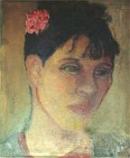The Annotated Nexus - Page 14
 14.0 On this page, Henry follows June and Jean from one Greenwich Village cafe to the next, seething with jealousy, bitter at the lesbian aspect of their relationship and at the Greenwich Village social circles in which they mingle.
14.0 On this page, Henry follows June and Jean from one Greenwich Village cafe to the next, seething with jealousy, bitter at the lesbian aspect of their relationship and at the Greenwich Village social circles in which they mingle.14.1 Woof woof! Woof!
See Nexus - Pg 1, Item 1.1. Henry follows June around like a dog, continuing the idea that he is subservient to her (especially since she is continuing an affair behind his back--as well as in his face--without much regard for how he might feel about it).
14.2 The Iron Cauldron
This seems to me a pretty obvious allusion to The Pepper Pot, one of the Greenwich Village clubs at which June (Mona) worked in the 1920s.
14.3 "the two tables nearest the windows were Mona's"
Assuming that this is The Pepper Pot, this implies that Mona (June) was working the top floor at this point (as opposed to the basement bar -- "The Catacomb"). Henry observes Mona at work, greeting customers, etc. Stasia (Jean) sometimes sits at a table until business slows down and Mona can join her for "an animated conversation." Henry burns with curiosity as to the subject of their conversation.
14.4 bottle fly
14.5 "Answer me that and I will write the history of Russia for you in one sitting."
Of course, the history of Russia is an epic one. The shortest contemporary one I found is 336 pages. This also refers to the fact that Mona and Stasia have Russian backgrounds; the implication being that the burden is equal to that of dischipering the two women combined.
 14.5 Sheridan Square
14.5 Sheridan SquareSheridan Square (also known as Christopher Street?) is located at the heart of Greenwich Village, bordered by West 4th St., Washington Place, and Barrow St. [ref]. Today it is the centre of the 'gay village' and has been the scene of the Stonewall riots and famed jazz club Cafe Society. [a bit of history here, and here it is on a map].
Miller also references this square on page 134.
14.6 "Minnie Douchebag's hangout"
This hangout is said by Miller to be at "one corner of the square," "always lit up like an old-fashioned saloon." Miller states that Mona and Stasia always "wind up" here, which is why he has followed them here.
"Minnie Douchebag" was referenced previously in Plexus. On page 197 of that book, Mona and Ulric discuss the increasing seediness of Greenwich Village. A restaurant is mentioned "on Sheridan Square," which Mona says is "Minnie Douchebag's hangout." She goes on to describe Minnie as "that crazy fairy who sings and plays the piano ... and wears women's clothes." Ulric recognizes the description and elaborates: "A real zany, by God. I thought at one point he'd climb the chandeliers. What a vile, stinking tongue he has too!"
If you're interested in Miller's low opinion of this quarter of Greenwich Village, read pages 197-198 of Plexus. Much of it conveys a distaste for the homosexuals who had come to dominate the area (Miller uses the derogatory "homo" to describe them; this piece is essential for anyone wishing to write a thesis about the subject of homosexuality in Miller's writings).
 Interestingly, my internet quest for "Minnie Douchebag" references only turned up this one on AmericanDialect.org. In its analysis of American swear words, it credits Miller's Plexus with introducing us to the word "douchebag" as an insult. This same article says that the Oxford English Dictionary cites Tropic Of Cancer for introducing the term "douche-bag" in print (in refernce to the object and not as an insult).
Interestingly, my internet quest for "Minnie Douchebag" references only turned up this one on AmericanDialect.org. In its analysis of American swear words, it credits Miller's Plexus with introducing us to the word "douchebag" as an insult. This same article says that the Oxford English Dictionary cites Tropic Of Cancer for introducing the term "douche-bag" in print (in refernce to the object and not as an insult).As for the identity of the real Minnie Douchebag, I can't say, but the most popular gay club on this square in the 1920s seems to have been called Stewart's Cafeteria [ref], if anyone cares to look into it.

14.7 "dear creatures"/ "dearies"
Earlier in the page, Miller refers to Mona and Stasia as "dear creatures," in a sarcastic way. He is disgusted with them; with their lesbianism, or at least their pose of lesbianism [the extent of which has never really been confirmed]. He continues to use this sarcastic term to describe the people in the club who give them "solicitous" attention upon arrival and "understood them so well and ever rallied to their support."
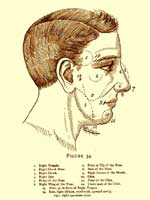 14.8 a Bertillon expert
14.8 a Bertillon expertAlphonse Bertillion (1853-1914) had devised a means of identifying criminals based on their physical traits [here are his methods]. While riding the subway home after spying at Minnie's, Miller is "amus[ed]" by the fact that a Bertillon expert would have trouble identifying "which was boy and which girl." This is a reference to the transgendered attire of the clientele at Minnie's restaurant.
And so, as Miller is on the subway, away from Mona and Stasia, he is most preoccupied, it seems, with his contempt for the nature of homosexuality and the betrayal of classic gender roles. This shows a conservative streak in Miller and/or is simply his anger over the social condition that is immediately threatening his marriage.
<--- previous Page 13 Next pages 15 & 16 --->
The Sheridan Square photo is from Iseult on Flickr.

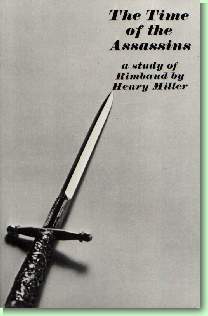




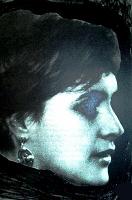

 I'm a bit confused by the layout of the original Pepper Pot, but it seems to me that it comprised of at least two floors and as many as four: the main level restaurant and a bar in the basement. In Jay Martin's Always Merry And Bright, he refers to June's employment at "The Catacomb." It's never explicitly clear that he is referring to The Pepper Pot, although the other Miller biographies refer to it as so. I think that The Catacomb--which implies a basement--is simply the basement bar of The Pepper Pot.
I'm a bit confused by the layout of the original Pepper Pot, but it seems to me that it comprised of at least two floors and as many as four: the main level restaurant and a bar in the basement. In Jay Martin's Always Merry And Bright, he refers to June's employment at "The Catacomb." It's never explicitly clear that he is referring to The Pepper Pot, although the other Miller biographies refer to it as so. I think that The Catacomb--which implies a basement--is simply the basement bar of The Pepper Pot.
 * In 1925, within a year of marrying Henry Miller, June took a job at The Pepper Pot to help support herself and the unemployed Miller. As a waitress here, she sold Miller's
* In 1925, within a year of marrying Henry Miller, June took a job at The Pepper Pot to help support herself and the unemployed Miller. As a waitress here, she sold Miller's 
 * While working on the manuscript for
* While working on the manuscript for  On August 5th, 2006, a production of the play
On August 5th, 2006, a production of the play 


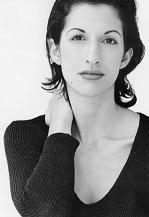
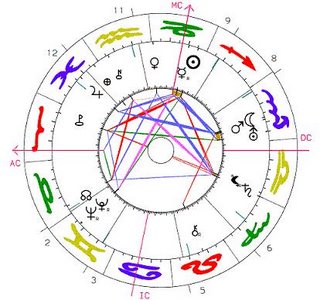 The chart design is credited on the website to Astrosoft. The full chart analysis (in symbols and German) can be found on the website.
The chart design is credited on the website to Astrosoft. The full chart analysis (in symbols and German) can be found on the website. 

 In October 1930, Miller sat as a model for American expat painter John Nichols, with whom he then shared a glowing yet fleeting friendship. Nichols, he believed, was destined to become one of the greats. Nichols offered support for Miller as he struggled as a writer in Paris (for example, he fed him from time to time), all the while painting portraits of Henry during a brief phase in which Miller sported an unkempt bohemian beard.
In October 1930, Miller sat as a model for American expat painter John Nichols, with whom he then shared a glowing yet fleeting friendship. Nichols, he believed, was destined to become one of the greats. Nichols offered support for Miller as he struggled as a writer in Paris (for example, he fed him from time to time), all the while painting portraits of Henry during a brief phase in which Miller sported an unkempt bohemian beard.


